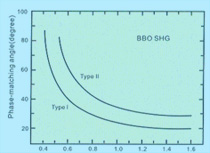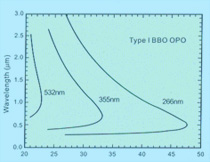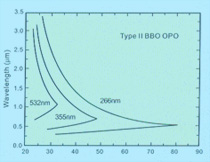|
Newlight BBO features
 Broad phase-matching range from 410 nm to 2100 nm Broad phase-matching range from 410 nm to 2100 nm
|
 Useful optical transmission from 190 nm to 3500 nm
Useful optical transmission from 190 nm to 3500 nm |
 Large effective
second-harmonic-generation (SHG) coefficient about 6 times Large effective
second-harmonic-generation (SHG) coefficient about 6 times
greater than that of KDP crystal |
 High
damage threshold of 10 GW/cm2
for 100ps pulse-width at 1064nm High
damage threshold of 10 GW/cm2
for 100ps pulse-width at 1064nm |
 High
optical homogeneity with δn ~ 10-6/cm
High
optical homogeneity with δn ~ 10-6/cm |
 Wide
temperature-bandwidth of about 55oC
Wide
temperature-bandwidth of about 55oC |
 Low thermo-optic coefficient
Low thermo-optic coefficient |
Structural and Physical
Properties
|
Crystal Structure |
Trigonal,
space group R3c, Point group 3m |
|
Cell
Parameters |
a = b = 12.532
Å, c =
12.717Å, Z = 6
|
|
Melting
Point |
1095 °C
|
|
Transition
Temperature |
925 °C
|
|
Mohs Hardness |
4 |
|
Density |
3.85 g/cm3 |
|
Specific Heat |
1.91 J/cm3x
K |
|
Hygroscopic Susceptibility |
Low |
|
Thermal Expansion Coefficients |
a, 4 x 10-6/K;
c, 36 x 10-6/K |
|
Thermal
Conductivity |
⊥c,
1.2 W/m/K; //c, 1.6 W/m/K
|
Linear Optical
Properties
|
Transparency Range |
189-3500
nm |
|
Optical Homogeneity |
δn
~ 10-6/cm
|
|
Absorption Coefficient |
<
0.1%/cm (at 1064nm) |
|
Sellmeier Equations
(λ in µm) |
no2=2.7359+0.01878/(λ2-0.01822)-0.01354λ2
ne2=2.3753+0.01224/(λ2-0.01667)-0.01516λ2 |
|
Refractive Indices
at 1064 nm
at 800 nm
at 532 nm
at 400 nm
at 266 nm
|
no = 1.6545,
ne
= 1.5392
no = 1.6606,
ne
= 1.5444
no = 1.6742,
ne
= 1.5547
no = 1.6930,
ne
= 1.5679
no = 1.7585,
ne = 1.6126
|
|
Thermo-optic Coefficients |
dno/dT
= -9.3 x 10-6/°C
dne/dT =
-16.6 x 10-6/°C |
Nonlinear Optical Properties
|
Phase-matchable SH Wavelengths: |
189 - 1750 nm
|
|
NLO Coefficients |
d11 = 5.8 x d36(KDP)
d31 = 0.05 x
d11
d22 < 0.05 x
d11
|
|
Effective
Nonlinearity Expressions |
dooe=
d31 sinθ
+(d11 cos3φ
- d22
sin3φ)
cosθ
deoe= (d11
sin3φ
+ d22 cos3φ) cos2θ
|
|
Electro-optic Coefficients |
γ11
= 2.7 pm/V, γ22,
γ31
< 0.1 γ11 |
|
Half-wave
Voltage |
48 kV (at 1064 nm)
|
|
Damage Threshold (Bulk)
at 1064nm
at 532nm
|
5 GW/cm2 (10 ns); 10 GW/cm2 (1.3 ns)
1 GW/cm2 (10 ns); 7 GW/cm2 (250 ps)
|
Application Examples
BBO
is of particular importance in the visible and far UV. A wide variety of phase-matching
applications are possible, including the following:
|
 Second, third, fourth and fifth harmonic generation of Nd
doping lasers Second, third, fourth and fifth harmonic generation of Nd
doping lasers
|
|
 Second harmonic generation to generate wavelengths as short as 204.8 nm Second harmonic generation to generate wavelengths as short as 204.8 nm
|
|
 Shorter wavelengths (193nm) can be generated by sum frequency mixing Shorter wavelengths (193nm) can be generated by sum frequency mixing
|
|
 Frequency doubling,
tripling and -mixing of Dye lasers Frequency doubling,
tripling and -mixing of Dye lasers
|
|
 Second, third and
fourth harmonic generation of Ti:Sapphire lasers Second, third and
fourth harmonic generation of Ti:Sapphire lasers
|
|
 Optical parametric amplifier (OPA) and optical parametric oscillators
(OPO) Optical parametric amplifier (OPA) and optical parametric oscillators
(OPO)
|
|
 Frequency-doubling
of Argon ion, Cu-vapor and Ruby lasers Frequency-doubling
of Argon ion, Cu-vapor and Ruby lasers
|
|
 Transverse field Pockel cells made from BBO useful when high average powers or Transverse field Pockel cells made from BBO useful when high average powers or
short wavelengths used
|
SHG and SFG
BBO is the only
NLO material which can be used to produce the fifth harmonic generation (5HG) of Nd:YAG
lasers at 213 nm. Because
of a small acceptance angle and large angular walkoff, good laser beam quality (small divergence,
good mode condition, etc.) is the key for BBO to obtain high conversion efficiency. Tight
focus of laser beam is not recommended.
|
NLO properties for harmonic generations with Type I
PM in BBO crystal |
|
Harmonics |
SHG |
THG |
4HG |
5HG |
|
Effective
NLO Coefficient(d36(KDP)) |
5.3 |
4.9 |
3.8 |
3.4 |
|
Acceptance
Angle (mrad-cm) |
1.0 |
0.5 |
0.3 |
0.2 |
|
Walk-off
Angle (°) |
3.2 |
4.1 |
4.9 |
5.5 |
BBO's
OPO and OPA
The
OPO and OPA of BBO are powerful tools for generating a widely tunable coherent radiation
from the UV to IR. The tuning angles of type I and type II BBO OPO and OPA have been
calculated, with the results shown in following, respectively.
|
 |
 |
|
Type I OPO Tuning Curves |
Type II OPO Tuning Curves |
Ultrafast Laser (Ti:sapphire)
Frequency doubling
and tripling of ultrashort lasers are the applications in which BBO shows superior
properties to KDP and ADP crystals.
BBO crystals as thin as 0.01mm (10
µm ) for these purposes
are available. A laser pulse as short as 10 fs can be efficiently frequency doubled with a thin BBO
crystal in
terms of both phase-velocity and group-velocity matching.
|